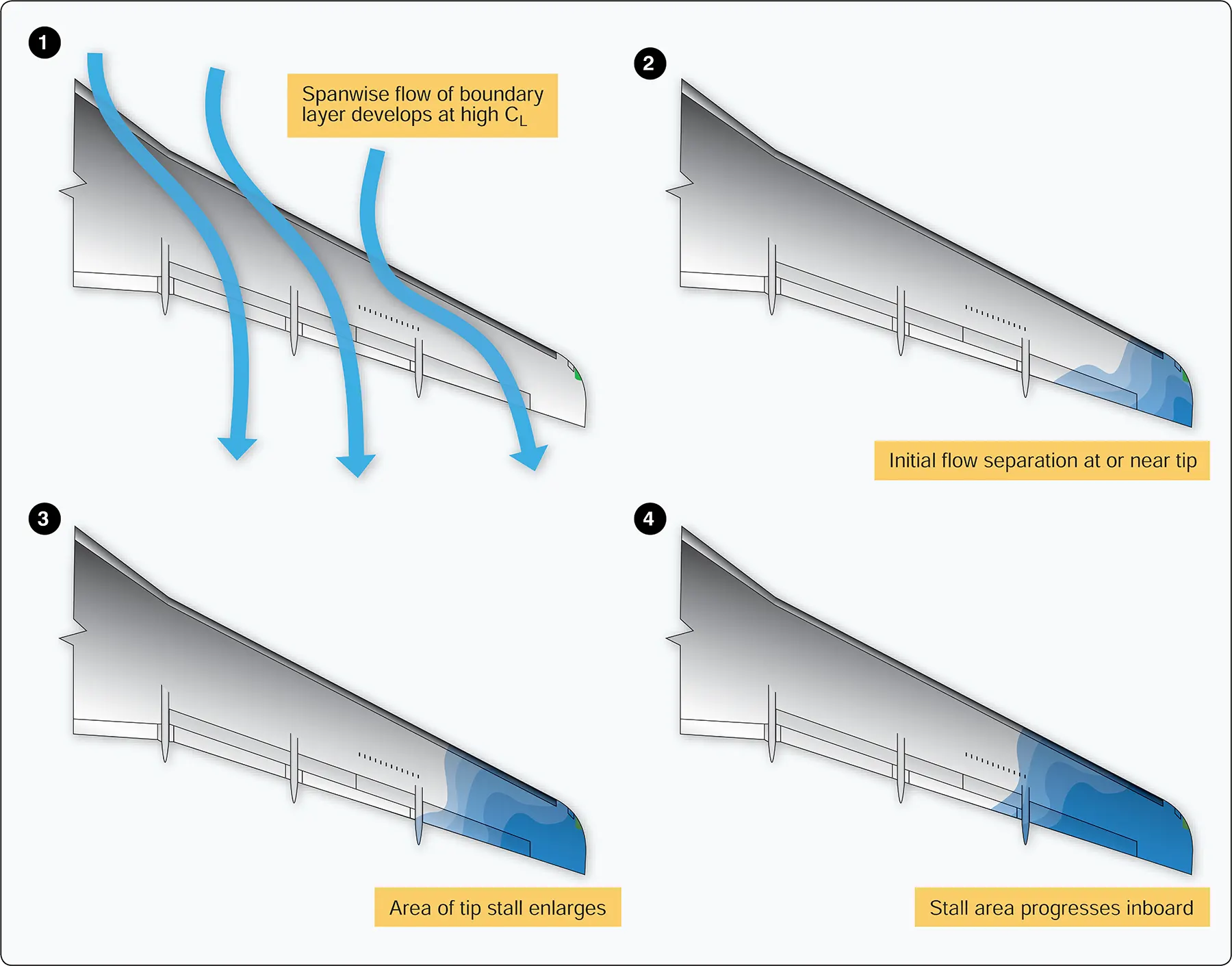The stalling characteristics of the swept wing jet airplane can vary considerably from those of the normal straight wing airplane. The greatest difference noticeable to the pilot is the lift developed vs. angle of attack. An increase in angle of attack of the straight wing produces a substantial and constantly increasing lift vector up to its maximum coefficient of lift, and soon thereafter flow separation (stall) occurs with a rapid deterioration of lift.
By contrast, the swept wing produces a much more gradual buildup of lift with a less well-defined maximum coefficient. This less-defined peak also means that a swept wing may not have as dramatic a loss of lift at angles of attack beyond its maximum lift coefficient. However, these high-lift conditions are accompanied by high drag, which may result in a high rate of descent. [Figure 1]

If a simple, straight-wing airplane’s airfoil is swept, a natural tendency arises that it will stall at the wing tips first. This is because the boundary layer tends to flow spanwise toward the tips. [Figure 2] The tendency for tip stall allowing the center of lift to move forward is greatest when wing sweep and taper are combined. To discourage a swept wing from stalling at the wingtips, manufacturers modify the wing spanwise with twist, changes in airfoil section, inclusion of vortex generators, or a combination of those modifications. This helps a pilot retain roll control initially if a stall is entered inadvertently.

Some T-tail configurations are prone to so-called deep stalls where the tail can become immersed in the wing wake at very high angles of attack and lose effectiveness. Such a situation can be accompanied by a high-rate of descent. Since high angles of attack can occur at any pitch attitude, even a pitch attitude with the nose below the horizon, it may seem counterintuitive in such a situation to take the appropriate recovery action, which is to push the nose down even further.
Deep stalls may be unrecoverable. Fortunately, they are easily avoided as long as published limitations are observed. On those airplanes susceptible to deep stalls (not all swept or tapered wing airplanes are), sophisticated stall warning systems such as stick shakers are standard equipment. A stick pusher (if installed), as its name implies, acts to automatically reduce the airplane’s AOA before the airplane reaches a dangerous stall condition, or it may aid in recovering the airplane from a stall if an airplane’s natural aerodynamic characteristics do so weakly. Pilots should avoid situations that would activate a stick pusher when close to the ground.
Pilots undergoing training in jet airplanes are taught to recover at the first indication of an impending stall instead of going beyond those initial cues and into a full stall. Normally, this is indicated by aural stall warning devices, annunciators, or activation of the airplane’s stick shaker. Stick shakers normally activate around 107 percent of the actual stall speed. In response to a stall warning, the proper action is for the pilot to apply a nose-down input until the stall warning stops (pitch trim may be necessary). Then, the wings are rolled level, followed by adjusting thrust to return to normal flight. The elapsed time will be small between these actions, particularly at low altitude where significant available thrust exists. It is important to understand that reducing AOA eliminates the stall, but added thrust will allow the descent to be stopped once the wing is flying again. Note that airplanes without vortex generators may stall with little to no buffet.
At high altitudes the stall recovery technique is the same. A pilot will need to reduce the AOA by lowering the nose until the stall warning stops. However, after the AOA has been reduced to where the wing is again developing efficient lift, the airplane will still likely need to accelerate to a desired airspeed. At high altitudes where the available thrust is significantly less than at lower altitudes, recovery may require significant pitch down to regain airspeed. As such, several thousand feet or more of altitude loss may occur during the recovery. The above discussion covers most airplanes; however, the stall recovery procedures for a particular make and model airplane may differ, as recommended by the manufacturer, and are contained in the FAA-approved Airplane Flight Manual for that airplane.
